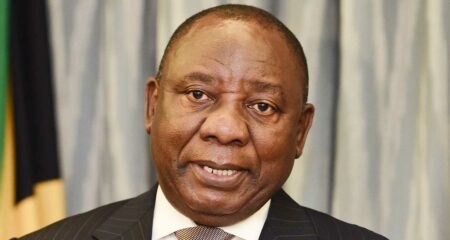 The last year when the lights stayed on every day in South Africa was 2017. But the continent’s most industrialised economy is now facing the worst blackouts ever, leaving most of its citizens without electricity for six-to-eight hours every day.
The last year when the lights stayed on every day in South Africa was 2017. But the continent’s most industrialised economy is now facing the worst blackouts ever, leaving most of its citizens without electricity for six-to-eight hours every day.
And there’s no end in sight. If anything, the country may lose power for as long as half a day during the southern hemisphere winter, from June to August.
The problem in South Africa has many idiosyncratic elements – and we’ll get to those in a moment — but offers a wider lesson to emerging nations. Electricity demand is fast increasing, and investment in generation facilities — particularly wind and solar – and transmission grids isn’t keeping up.
From India to Brazil and from Nigeria to Bangladesh, power shortages are becoming more common. Unless governments get their act together, electricity failures will become a serious handicap to economic growth. For the first time in decades, the number of people without any access to electricity rose last year, reaching nearly 775 million.
In South Africa, households and small businesses have endured rolling blackouts every day so far this year. In 2022, they suffered a record 208 days of electricity shortages, up from 75 in 2021 and 54 in 2020. Not only are the blackouts more frequent, but they are also lasting much longer. Five years ago, the power shortage was typically about 1GW, requiring just one hour a day of load shedding on average. By late 2022, the shortfall reached 6GW.
Read: De Ruyter quit as Eskom CEO because ‘it’s a tough job’: Ramaphosa
Eskom, South Africa’s state-owned utility monopoly, is again looking for a chief executive after André de Ruyter’s resignation in December. President Cyril Ramaphosa, who made a fortune in coal mining, said earlier this month he would “applaud” whoever agrees to take the job. That’s not a joke. Running the South African utility surely ranks as the worst job in the global energy industry.
Honest job ad
An honest job ad for the role should read something like this:
Eskom seeks a new CEO. Reporting to the board, the successful candidate must end more than five years of blackouts in 12-18 months – or he/she will become a convenient scapegoat and public punching bag. You should be comfortable dealing with corrupt politicians, a decrepit park of power stations, a meagre maintenance budget and a coal lobby determined to stop expansion into solar and wind power. Some finance experience is desirable as the company is running an unsustainable debt load of more than US$20-billion. Salary is negotiable, but paid in a currency that, due to the electricity crisis, has fallen 40% against the US dollar in the last five years. Should you choose to apply, please send us your CV to [email protected].”
Of course the ad would be missing some relevant background — Ramaphosa wouldn’t want to discourage too many potential applicants.
For example, De Ruyter survived at least one known assassination attempt. Criminal gangs routinely steal fuel, equipment and supplies. Government officials, trade unions and business groups are all hostile, while US and Europe would want whoever becomes CEO to say goodbye to all the coal-fired power stations, offering no realistic supply alternative.
Read: Departing Eskom CEO De Ruyter will stay on until March
Ramaphosa held emergency meetings last week on the electricity crisis, cancelling a trip to the World Economic Forum in Davos. So far, all his proposals are piecemeal. South Africa doesn’t need bandages, as the government is proposing, but open-heart surgery. First, it needs to recognise that the problem is not the management of Eskom but government policy. Changing the CEO without changing the policy — or providing financial help to the utility — won’t resolve anything. The government needs to take at least on a portion of the more than $20-billion in net debt Eskom carries — some of it the result of lack of payment by customers and below-market power prices. Without debt restructuring, Eskom wouldn’t be able to invest. And without investment, the blackouts would continue.
 Second, the government needs to split the role of Eskom, which today is in charge of both electricity generation, and power transmission and distribution. The utility should concentrate in generation, maintaining its fleet of coal-fired stations, its sole nuclear plant, and diesel-fired stations. A new standalone entity could focus on transmission, investing in new high-voltage, long-distance grids for renewable projects. Right now, lack of transmission capacity is hindering wind and solar additions. The government should also further liberalise generation, opening the way for more private sector self-production.
Second, the government needs to split the role of Eskom, which today is in charge of both electricity generation, and power transmission and distribution. The utility should concentrate in generation, maintaining its fleet of coal-fired stations, its sole nuclear plant, and diesel-fired stations. A new standalone entity could focus on transmission, investing in new high-voltage, long-distance grids for renewable projects. Right now, lack of transmission capacity is hindering wind and solar additions. The government should also further liberalise generation, opening the way for more private sector self-production.
Third, Ramaphosa needs to protect Eskom from the gangs who profit stealing coal and diesel, and sabotage the power plants – probably to cash in from maintenance contracts. The acute blackouts of December and January are due as much to sabotage as to breakdowns. The lack of police action is perplexing.
Read: Eskom CEO De Ruyter poisoned with cyanide: report
Finally, South Africa, where the coal mining lobby is deeply embedded in the government, needs to embrace renewable energy. Solar and wind could generate a quarter of the country’s power under the right circumstances. Contrary to the view of some ministers, green energy is a big part of the solution. But embracing it doesn’t equal abandoning coal in the short or even medium term. South Africa still needs well-functioning and maintained coal-fired plants if it is going to end the rolling blackouts. And Ramaphosa should say that, too, even if Europe and the US aren’t pleased about it. — Javier Blas, with Elaine He (c) 2023 Bloomberg LP




